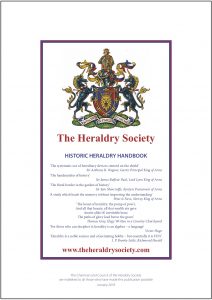When our local canton changed its name a year ago, we piloted the introduction of the “ancient branch name” provisions, as discussed in the October 2023 cover letter. A few months later, the administrative handbook was updated to reflect this change, as well as cover an alternate route to establishing ancient branch names and arms, as discussed in the March 2024 cover letter.
Continue reading “Two Routes to Ancient Names and Arms”Category: Heraldic Policy
An Ancient Branch Name
When the Canton of Whyt Whey resolved to change its name to Appleholm last year, it simultaneously submitted a household name similar to its original name in order to memorialize this bit of its history. We went down this road because there was no option to preserve the old name as our “ancient name” the way we already had with “ancient arms.”
So I was surprised to hear this summer that our name change was pended to consider establishing support for ancient branch names. The change provoked a fair amount of discussion but in the end we decided to take the opportunity to preserve the old name.
Continue reading “An Ancient Branch Name”Who Owns the Copyright to the LoARs?
A couple of days ago, I was working on getting some old LoARs ready for publication online when I stopped to consider who held the copyrights to them.
[As with all of the legal commentary on this site, the below should be read with the knowledge that I am not a lawyer, and none of this should be taken as legal guidance — I’m just attempting to describe a somewhat-obscure issue as best I understand it.]
Because the letters were created by volunteers rather than employees, they are not “work for hire,” and I don’t think any past Sovereigns have been asked to sign agreements on the subject.
Continue reading “Who Owns the Copyright to the LoARs?”Why You Can’t Register Marshalled Armory
Considerations of armorial designs including straight-line per-pale or quarterly field divisions often include a discussion of whether they have “the appearance of marshaling.” Putting aside the question of how we answer that question (already ably addressed elsewhere, see here and here), one might wonder why this is an issue — why doesn’t the SCA’s College of Arms register armory that has the appearance of marshalling?
I believe the answer is that marshalled arms were not issued as such by period heraldic authorities, nor did newly-armigerous families assume already-marshalled arms.
Instead, each individual coat of arms was granted (or assumed) independently, and it was only after that point they were ever combined via impalement or quartering (or sometimes more esoteric arrangements as seen in Iberia).
Continue reading “Why You Can’t Register Marshalled Armory”A Revised Armory Conflict-Checking Checklist
SENA devotes over 10,000 words to conflict checking armory, which the below guide attempts to summarize in one-twentieth of the space.
Many details have been omitted, so references are included to the relevant sections of SENA to facilitate additional research as needed. Continue reading “A Revised Armory Conflict-Checking Checklist”
A Badge for Heraldic Artists
 Most people who’ve had any contact with the Society’s College of Arms would recognize the badge of the Heralds — “vert, two straight trumpets in saltire Or” — which may generally be displayed by anyone working for or associated with the College.
Most people who’ve had any contact with the Society’s College of Arms would recognize the badge of the Heralds — “vert, two straight trumpets in saltire Or” — which may generally be displayed by anyone working for or associated with the College.
But there wasn’t a distinctive badge reserved specifically for the artists who assisted the College by illustrating armory, a role that in period was referred to as a “herald painter.” (For more on the history of herald painters, see this essay by Robert Parsons, who held that role for the British College of Arms.) Continue reading “A Badge for Heraldic Artists”
An Updated Catalog of IAP Submissions
Back in 2017, I dug through a decade’s worth of LoARs and posted a set of examples of Individually Attested Pattern submissions.
I’ve updated that listing a handful of additional times over the subsequent years, but when I was gathering additional items for this update I realized I wanted to make a few changes to the way the information was organized and figured that was a good opportunity to create a new document, which I have now posted as “A Catalog of Individually Attested Pattern Submissions.”
Heraldic Authority In the Earliest Bylaws of the SCA
The Society for Creative Anachronism started as a party in 1966 and was named as a joke, but over the subsequent years elaborated a set of governing policies which today control an international not-for-profit organization with over a hundred thousand participants.
It’s interesting to look back at the early practices of the organization to see the seeds that grew into the structure we know today, and so I was pleased to discover a copy of the earliest bylaws archived on the web site of Master Justin du Coeur, a former historian of the East Kingdom. Continue reading “Heraldic Authority In the Earliest Bylaws of the SCA”
An Overview of Historical Armory Practices in England
What Does the Brigantia Herald Do?
On April 25, 2020, as part of the East Kingdom Officer Schola online event, Master Malcolm Bowman led a session reviewing the role of two kingdom-level heraldic positions he holds, including that of Brigantia Herald.
I am attaching my notes from this session below in hopes that they might be of interest to other members of the community, but please be aware that this is not an official transcript and may contain errors or omit relevant details.
The Brigantia Herald has overall responsibility for all heraldic activity in the kingdom, including courts, events, and submissions. Continue reading “What Does the Brigantia Herald Do?”

